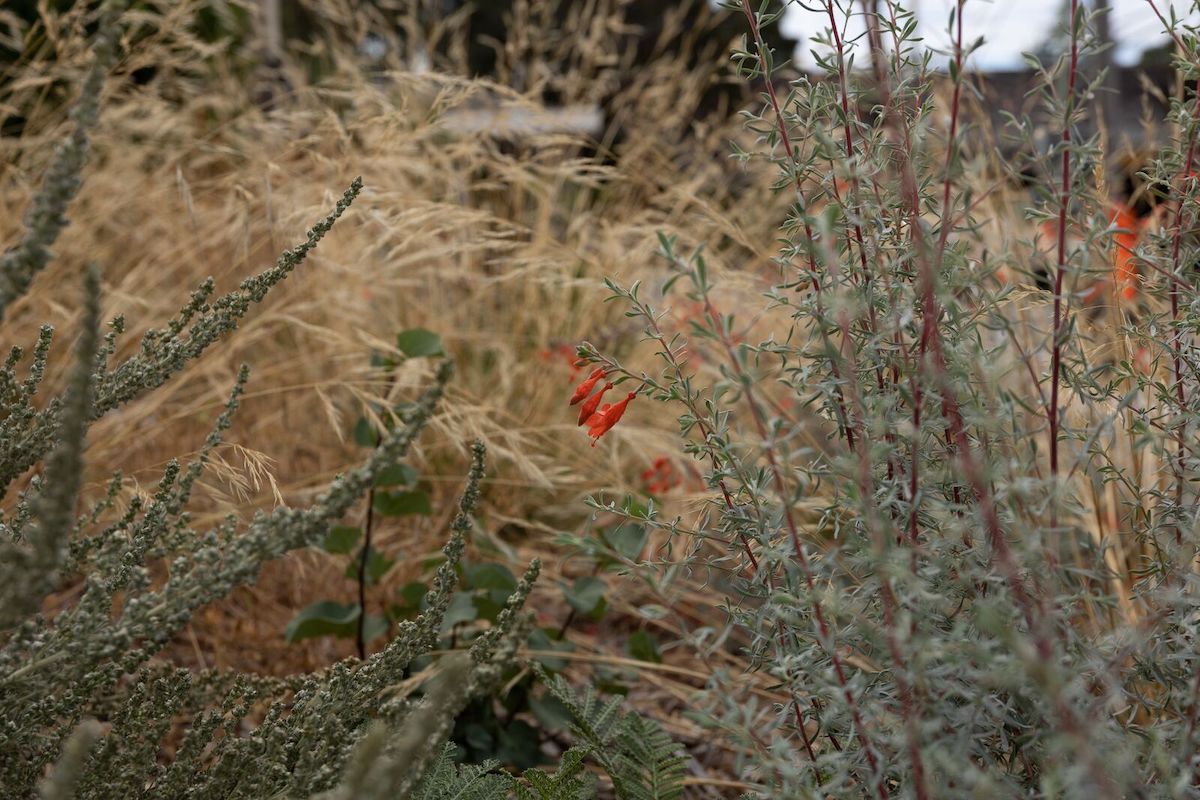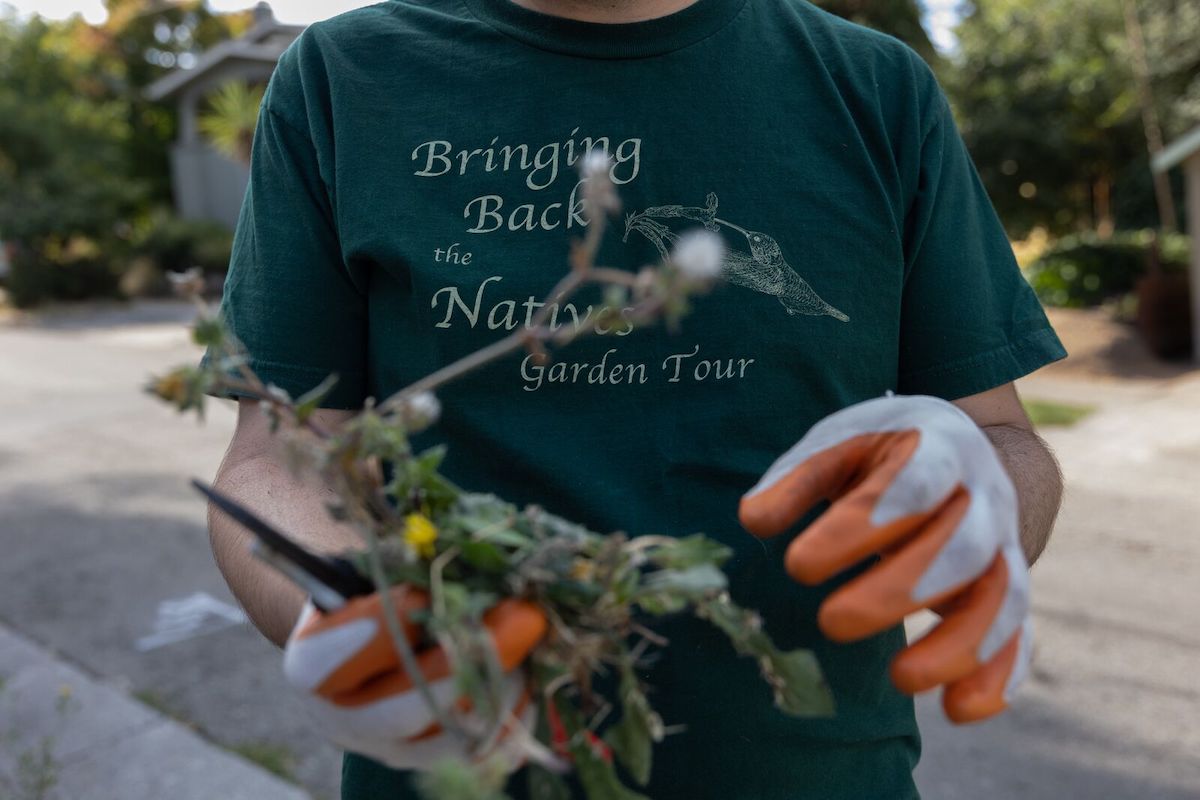Leafy streets with birds chirping, water flowing through little brooks, and wildlife thriving in patches of grass and shrubs may not be the first image people see when they think of Oakland—but with more residents tending native plant gardens, it could be.
“It doesn’t click until you realize that the animals we love to watch, the foxes, coyotes, birds—birds are a huge one, people love to watch the birds—their lives depend on these plants that they evolved with,” said Beth Wurzburg, a local member of the East Bay Chapter of the California Native Plant Society who helps manage The Native Here Nursery in Tilden Regional Park.
Native plants are vital to the health and longevity of California’s most delicate ecosystems but they also provide practical benefits to homeowners and renters. Many of California’s native plants are drought tolerant and are an excellent water-saving landscape option. Native plant nurseries are cropping up around the East Bay and residents have been ripping out their lawns in favor of manzanita bushes, golden poppies, and ceanothus. The East Bay Municipal Utility District will even pay people to start the process of converting their lawn.
For years, native plant enthusiasts like Wurzburg have been working to restore biodiversity, on both the small- and large-scale across California. While adding native plants to a residential area can seem like a drop in the bucket, according to native plant experts it can be essential for our diverse local wildlife. With California’s biodiversity in increasingly critical condition, experts say now is the time to start planting.
California is a significant biodiversity “hotspot”—one of 36 globally—holding more species of plants and animals than any other state in the nation. It is also the most threatened.
According to the California Department of Fish and Wildlife, this is “…in large part due to habitat loss and conversion, impacts from invasive species, and climate change.”
Wurzburg said that California’s biodiversity can be aided by urban residents. “Our homes, our roads, all of this interferes with what was habitat, so everyone can do their part to try and recreate what was there to help our animal friends who live among us.”
A spoon and some milkweed

Local pollinators, like butterflies and moths, rely on native “host” plants to lay their eggs. Even if butterflies are present in a space, it doesn’t mean that an area has the right conditions for them to reproduce. Additionally, an overwhelming majority of birds need insects to feed their chicks, and caterpillars provide a significant source of those nutrients.
Creating a space for wildlife, as well as a beautiful garden for himself and his partner, is what motivates Oakland resident Brian Teng to keep up his own native plant garden.
Teng has memories of working with his mother in their home garden as a child. He also studied ecology in his undergraduate program and now works for the Golden Gate National Parks Conservancy. However, his own journey to start gardening with native plants has a more humble beginning. When Teng started cultivating native plants in his own garden, he didn’t own a shovel, so he grabbed the next best thing: a kitchen spoon.
“I bought some milkweed and brought it home and was like ‘How do I get this in the ground?’ so I grabbed the spoon,” said Teng. “I actually used the spoon for like six months.”
Teng received his first native plant from a friend, and from that day on, he was hooked. He watched over 200 hours of YouTube videos on native plant gardening and several years later, he has converted most of the yard space at his Millsmont home to be a native plant haven. Teng’s garden currently wraps around his house, but he said he started by putting small plants in a couple at a time. It was a process of trial and error as he learned what plants could go where. He did the process entirely on his own, which contrasted with the professionally landscaped native plant gardens Teng was used to seeing.
“That’s purely money, I don’t have the money to hire a landscape designer,” said Teng. “I was buying plants five at a time because even buying all the plants for this yard would have been too much at one time.”
Teng drew inspiration from gardens he saw on the Bringing Back The Natives Garden Tour. Later, his garden was featured on the tour. However, unlike some professionally designed native gardens, his is laid out by zones. Some areas are for spiky plants, some for scented plants, and others are for just trees. He also lets his plants brown and die naturally as they would with typical seasons.
Julie Benson, another Oakland resident and native plant gardener featured on the bring back the natives tour, started like Teng by slowly converting her garden. She was also conscious about water and wanted to incorporate plants that would be drought tolerant. While Benson received some professional help later in the process, she has done most of the work on her own. Now, Benson has been native plant gardening for almost two decades and finds comfort in the space she has cultivated for herself and the wildlife around her.
“I’m in the heart of Oakland and it’s a refuge and I also feel like I’m contributing in some way to the ecology of our local area and our local animals that live here,” Benson said.
Saving water and money and creating a fire-proof landscape

Aside from the ecological benefits, native plant gardens can have a variety of benefits for homeowners. A significant portion of native plants have evolved to thrive through California’s seasons with unpredictable precipitation levels. As a result, these plants require less watering and maintenance over time.
Native gardens can be so water efficient that EBMUD has a rebate program for homeowners and businesses who convert their lawns to a “water-wise” landscape. While residents don’t have to put in native plants specifically, they can receive a higher rebate if they do. The standard rebate offered is $1.25 per square foot converted from grass to water-efficient plants, while a “super” rebate for people putting in a majority of native plants offers $2.50 per square foot. There is no minimum lawn size for the rebate to be applicable, but the rebates do max out at $ 2,000.
EBMUD started the lawn conversion program in 2014 and has issued around 3,700. A spokesperson from EBMUD said fall and winter are good times for folks considering converting their lawns since the upcoming rain can help naturally water these plants.
Most native plants require a year of consistent watering to become established. Residents wanting to incorporate native plants can then adjust their watering schedule depending on their preference for water use and landscaping aesthetics. Some gardeners, such as Teng, choose not to water their plants after their initial watering period.
“We’ve had all those really long droughts so it’s like ‘how can I plant something that can make it through a drought with little water or no water, but we consistently get water bills and ours is way below the average for a house of our size,” said Teng.
Native gardens may also aid in wildfire prevention, if planted properly. A recent study by researchers at the Southern California Academy of Sciences looked at fire protection in the wildland-urban interface, the area where nature and lived environments meet. Their findings suggest that lightly irrigated native plants planted around homes could reduce fire hazards while still “possessing other desirable features of utilizing native vegetation.”
While this research is emerging, residents should still be cautious of plants labeled as fire resistant, according to the California Department of Forestry and Fire Protection’s fire smart landscaping page. Cal Fire emphasizes that residents should focus more on plant placement than plant type. Oakland residents wanting to convert their lawn should keep the defensible space—the area between a home and surrounding vegetation—in mind when planting new gardens.
How to start your own native plant garden

While converting a lawn space may seem daunting, there are a variety of tools available. Native plant enthusiasts say that even having potted plants can make a difference.
“For your own home, whether you have a balcony, where you can plant plants, a few pots, you can start small,” said Wurzburg. “There are relatively easy plants to start out with that are different sizes.”
The California Native Plant Society’s online tool Calscape has a large database of native plants. Gardeners can use the website to search which plants are right for their area and get information on when to plant them, how to care for them, what wildlife they support, and more. The plants listed range from small annuals and perennials that can fit in a pot, to large plants better suited for a front lawn or backyard.
For Oakland residents looking for garden inspiration, The Bringing Back the Native Garden Tour, provides a significant repository of photos and videos of local plant gardens. There are virtual tours of different residential gardens across the Bay Area and in-person tours offered yearly. Kathy Kramer, the creator of the tour, has a variety of resources available to new and veteran native plant gardeners, including a list of professional landscapers that incorporate or specialize in native plant landscaping.
EBMUD also offers information for residents on water-wise plants as well as fire smart landscaping for implementing those plants.
Whether it’s providing space for more wildlife, converting a lawn to save water, or just adding some green to a home, native plant enthusiasts stress the benefits that native plant gardens can bring to all of Oakland’s residents.
“There’s something about being outdoors and being in nature that really helps people,” said Wurzburg. “When people plant native plants and create native habitats, nature comes to them.”

